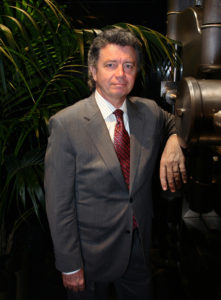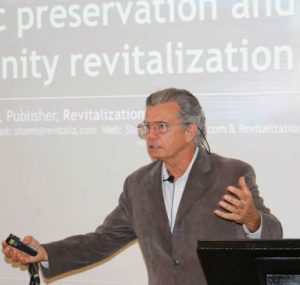REVITALIZATION is the official publication of RECONOMICS Institute.
The Washington, DC-based RECONOMICS Institute helps boost the success rate of revitalization and resilience initiatives by training certified RISING PLACES Practitioners (RPP). These public and private professionals provide the crucial missing ingredient behind the failure of most such initiatives to make a significant impact: the lack of a strategic renewal process.
Most places and organizations are good at creating projects that contribute to revitalization and resilience, but lack a cohesive, adaptive, ongoing process focused on the desired end result: resilient economic, social and environmental renewal. This process also enables them to integrate revitalization and resilience efforts, creating a synergy that reinforces both.
 REVITALIZATION is published to achieve five goals:
REVITALIZATION is published to achieve five goals:
1) INSPIRATION: In these days of tragedy-obsessed new media, increasingly-dysfunctional national governments, and catastrophic climate change, it’s not easy to be optimistic. One of our roles is to share news of how our world is getting better. Solutions invented in one community are often replicable where you live, giving you the chance to move beyond optimism to action.
2) AWARENESS: If you’ve read the Preview of RECONOMICS or heard one of REVITALIZATION Editor Storm Cunningham‘s talks in the past decade, you know that generating increased confidence in the future of a place is the single most important goal of any revitalization effort. Many struggling communities are working hard for a comeback, and many prosperous places are working hard to improve their quality of life and resilience. But it’s not just among residents that that confidence must be boosted: it’s also among those outsiders who might be able to bring new jobs and resources to the area. Excellent efforts won’t do much to build confidence if no one outside the community or region knows about them. So, one of our roles is to make the world aware of revitalization and resilience efforts they might not have heard about otherwise.
3) EDUCATION: But increasing confidence in the future of a place isn’t enough. When those new resources come to town, local public and private leaders need to understand how to put them to work to magnify and perpetuate their revitalization effect. Funding for redevelopment, revitalization and resilience is fairly common. Knowing how to leverage those investments is rare. So another goal of REVITALIZATION is to share knowledge, tools and insights as to what works.
4) FACILITATION: Our fourth goal is to help those with resources find mutually-beneficial opportunities that make this world a better place for all. Many of those opportunities are found on our Business page.
5) INTEGRATION: There are literally millions of talented people around the world trying to create resilient prosperity in their community or region. But almost all of them are working in a “silo”. Some only work on one type of asset (infrastructure, heritage, watershed, etc.). Some only work in a limited area, such as downtown or a waterfront. Some only work in one phase, such as planning or projects. But communities and nations are complex, living systems whose renewal requires comprehensive, ongoing effort. So, our final goal is to bring together all of these silos, and get professionals to “look up and see each other”: to become more aware of others’ roles. So our fifth goal is to enhance collaboration and system-level approaches.
Everyone—progressive and conservative—enjoys bringing ugly, unhealthy, unproductive places back to life. Everyone has a different perspective on what revitalization looks like, and what contributes to it. REVITALIZATION is where we learn together, and get inspired together.
REVITALIZATION is the only place where representatives of academia, non-profits, foundations, businesses, and government (at all levels) from all over the world come together to focus on creating a healthier, more-prosperous and resilient future for all.
REVITALIZATION is also the only place where professional “silos” dissolve, and readers are exposed to the repurposing, renewing and reconnecting of ALL asset types needed to regenerate our future: ecosystems, watersheds, fisheries, climate, agricultural, urban, rural, infrastructure, brownfields, social, historic, economic and post-catastrophe.
Who edits REVITALIZATION?
 Storm Cunningham is the Editor of REVITALIZATION. He is also the Executive Director of RECONOMICS Institute, which is the publisher.
Storm Cunningham is the Editor of REVITALIZATION. He is also the Executive Director of RECONOMICS Institute, which is the publisher.
Since 2002, Storm has been a resilient prosperity coach to leaders of cities, nations, non-profits and businesses worldwide.
His clients have included mayors, governors, heads of federal agencies, members of the U.S. Congress, provosts of universities, foundation presidents, Fortune 500 executives, Chamber of Commerce CEOs, and nonprofit leaders.
In this confidential role, he normally stays in the background, so his clients can take full credit when they launch leading-edge policies and initiatives related to revitalization and resilience.
But in his role as keynoter and workshop leader, he’s very much in the foreground. For almost two decades, Storm has been presenting at planning, sustainability, community regeneration, economic resilience, and natural resource restoration conferences.
George Ochs, Managing Director of JP Morgan, says: “Storm Cunningham is the world’s thought leader on community revitalization and natural resource restoration.”
Many credit Storm’s groundbreaking 2002 book, The Restoration Economy (Berrett-Koehler), with catalyzing today’s explosive growth of restorative, resilient redevelopment all around the world. Tim Fields, Assistant Administrator for Solid Waste & Emergency Response, U.S. Environmental Protection Agency called it “A modern classic. Few books have so quickly and effectively reshaped our dialogue and assumptions about the future of economic development.” Buy it here.
His 2008 book, Rewealth (McGraw-Hill Professional) further accelerated the trend with case studies of leading-edge practices. Its Foreword was written by four-term Indianapolis mayor, William H. Hudnut, III. George Canetti, Senior Business Developer, Ameresco Canada declared, “All national politicians and community leaders should be forced to read Rewealth.” Buy it here.
 His 3rd book is RECONOMICS: The Path To Resilient Prosperity (January 9, 2020). It’s a guide to healing economies, societies and nature for policymakers, real estate investors and entrepreneurs. Buy it here.
His 3rd book is RECONOMICS: The Path To Resilient Prosperity (January 9, 2020). It’s a guide to healing economies, societies and nature for policymakers, real estate investors and entrepreneurs. Buy it here.
Given the $16 trillion that’s about to be unleashed by the global response to climate change, this new book is well-timed. Much of that investment will repurpose, renew, and reconnect our at-risk natural, built, and socioeconomic environments, creating myriad new industries and jobs. Combine that with the $10 trillion global construction industry’s increasing focus on redevelopment and infill over sprawl, and the impact will alter local economies forever.
While there are thousands of experts related to creating redevelopment plans and projects, Storm’s specialty is the actual process that produces the desired end result: revitalization (economic growth, increased quality of life, etc.). All around the planet, he helps leaders avoid the two most common causes of failed revitalization and resilience efforts: 1) lack of an effective strategy; 2) lack of a reliable process for funding and implementation.
His workshops help public and private leaders understand: 1) the dynamics of community/regional economic revitalization, and 2) how to strategically position their career, or their organization, within that process. Most places already have all the organizations and resources they need to achieve revitalization or resilience. But these assets aren’t organized into a productive renewal process.
Storm’s work breaks down silos, opens up flows, and creates greater community cooperation. As a result, his client communities and organizations more easily collaborate with and/or get funded by those renewing other aspects of the built, natural, and socioeconomic environments.
Storm has helped colleges and universities raise millions of public and private dollars to endow new chairs and launch new institutes related to community redevelopment, natural resource restoration, and climate adaptation. From 2006-2009 Storm was Distinguished Visiting Professor at Seneca College (Canada’s largest college) in Toronto.
Storm’s public and private clients span dozens of countries. His 100+ global client list includes:
US State Department, Boeing, Harvard University, Ontario Chamber of Commerce, Israel Planners Association, European Property Italian Conference, University of Guadalajara, National Arbor Day Foundation, U.S. Environmental Protection Agency, American Institute of Architects, Project Management Institute, US Embassy (Poland), Governor of Montana, Canadian Urban Institute, Santee Cooper, Urban Land Institute, University of Texas, Leadership Cleveland, and many more.
Storm lives in Arlington, Virginia with his wife, Dr. Maria MacKnight.
From 1996-2002, he was Director, Strategic Initiatives at the Construction Specifications Institute, a technical society of about 14,000 architects, engineers, and manufacturers.
Storm was an A-Team SCUBA medic with the U.S. Army’s 7th Special Forces (Green Berets), and is still an avid SCUBA diver, motorcyclist, and amateur herpetologist.
Watch Storm’s 2010 TEDx talk in Washington, DC.
See https://StormCunningham.com for more on Storm’s work.
CONTACT
Storm can be reached at 1-703-887-2142 (cell).
Or email him at storm@reconomics.org
NOTE: Jay Pipavat is our talented webmaster at EastWest Web.
Email him in India if you’d like to publish a magazine similar in format to this one.


